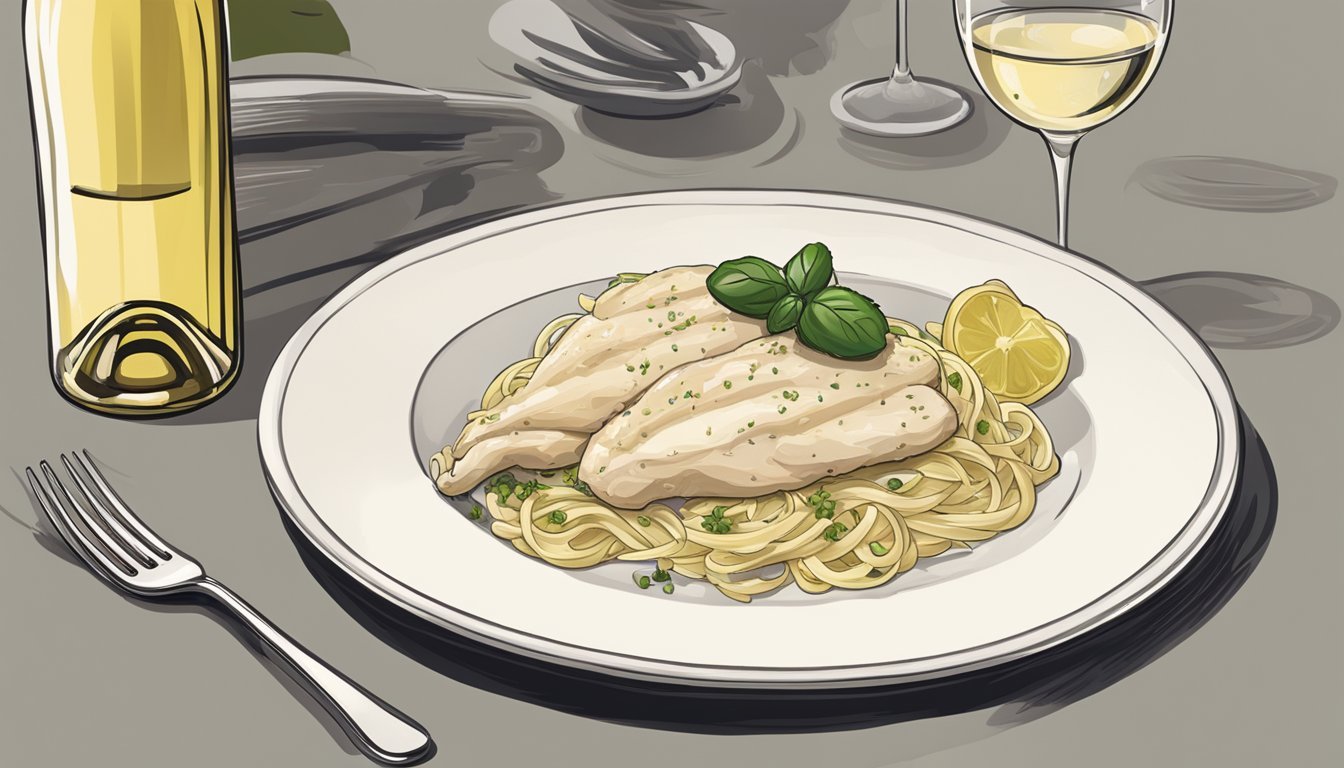What Wine Goes Well with Chicken Alfredo
Perfect Pairing Guide
Selecting the right wine to accompany chicken Alfredo (What wine goes well with chicken alfredo?) can elevate this classic dish to new culinary heights. The creamy, rich sauce of this beloved pasta (What wine goes well with pasta?) is well complemented by wines that can cut through its density and enhance its flavors without overwhelming them. To create a harmonious dining experience, one may consider light-bodied white wines that offer a crisp contrast to the dish.
Pinot Grigio is frequently recommended for its light body and citrus notes, which can cleanse the palate between bites of creamy Alfredo sauce. Chardonnay brings a medium body with hints of buttery notes that can match the sauce’s richness, while a touch of oak adds an elegant complexity. On the sweeter side, Riesling, with its aromatic profile and high acidity, provides a pleasing balance, countering the dish's creamy texture and highlighting its inherent flavors.
Understanding the Basics of Wine Pairing
When selecting a wine to complement a dish like chicken alfredo, it is crucial to consider the interaction between the dish's flavors and the characteristics of the wine.
Importance of Balance in Flavor Profiles
The balance between a wine’s flavor profile and a food's taste is fundamental. For a rich, creamy sauce like that in chicken alfredo, wines should not overpower with bold flavors but instead should complement the dish's richness and creamy texture. A medium-bodied wine with fruity notes can contrast the richness while harmonizing with the dish's overall flavor.
Role of Acidity and Tannins in Wine
Acidity in wine can cut through the richness of a creamy sauce, cleansing the palate and making each bite as satisfying as the first. Wines with high acidity, like Riesling, work especially well. Conversely, tannins can feel overwhelming when paired with creamy dishes, so wines lower in tannins are preferable.
Wine's Body and Texture Match
Pairing a wine to a dish involves matching the body and texture. A full-bodied wine can overwhelm a dish like chicken alfredo, while a light and crisp wine may be too delicate. The goal is to match the wine's body with the weight of the dish for a harmonious experience.
Impact of Wine's Aroma on Pairing
The aroma of wine can either enhance or clash with the flavors of a meal. For a dish with a creamy sauce, wines exhibiting buttery, earthy, or oaky aromas can complement the food. The aromatic match can elevate the overall dining experience, heightening the enjoyment of both the dish and the wine.
Influence of Wine Age on Pairing
The vintage and aging process of a wine can influence its suitability for pairing with certain dishes. Wines that have aged may have an evolved flavor profile that features less fruit and more savory characteristics. Depending on the dish, this can either complement or detract from the dining experience.
Selecting Wines for Chicken Alfredo
When choosing wine to pair with chicken Alfredo, the key is to complement the rich, creamy sauce of the dish and harmonize with the savory notes of parmesan cheese.
Best White Wines for Chicken Alfredo
Chardonnay: A medium-bodied Chardonnay, especially one with buttery notes and a hint of oak, meshes well with the creamy texture of Alfredo sauce. An unoaked Chardonnay can provide a cleaner contrast with refreshing acidity.
Pinot Grigio: This Italian white wine, known for its light, crisp character with notes of pear and green apple, offers a delightful balance to the dish’s richness.
Sauvignon Blanc: With its zippy acidity and citrusy flavors, Sauvignon Blanc cuts through the sauce’s thickness and complements the dish with a refreshing finish.
Viognier: A wine that provides fragrant notes of peach, tangerine, and pear, Viognier can elevate chicken Alfredo with its fruity profile and aromatic qualities.
Red Wines to Consider
Pinot Noir: A light red with fruity notes of red currant and cranberry can complement the creamy sauce without overpowering it.
Barbera: This Italian red wine features vibrant acidity and smooth tannins, offering a refreshing contrast with its earthy, spicy profile.
Merlot: A medium-bodied Merlot with ripe fruitiness can also pair nicely, provided it has sufficient acidity to cut through the richness of Alfredo sauce.
Pros and Cons of Sparkling Wines
Pros: Sparkling wine's festive bubbles and acidity can act as a palate cleanser between bites, marrying well with the creamy texture.
Cons: The complexities of Alfredo sauce might be overshadowed if the sparkling wine is too delicate.
Italian Wines as a Regional Choice
Italian Pinot Grigio: An authentic choice for an Italian dish, offering a harmonious blend with its light body and crisp pear and apple flavors.
Orvieto: This less-known Italian white wine brings together a blend of grape varieties, often resulting in a wine that is both fruity and floral, with enough acidity to accompany the dish.
Pairing Wine with Variations of Chicken Alfredo
When considering wine pairings for variations of Chicken Alfredo, attention must be paid to the additional flavors introduced. The wine selected should complement the richness of the cheese and creamy texture of the sauce, while also balancing any added ingredients.
With Meat Additions
For Chicken Alfredo dishes that feature additional meats such as bacon or prosciutto, a medium-bodied white wine like Chardonnay excels. With its hint of oak and buttery notes, Chardonnay harmonizes with the smoky flavors and enhances the creamy texture.
Bacon: Chardonnay (notes of butter, slight oak)
Prosciutto: Sauvignon Blanc (notes of green apple, citrus)
With Vegetable Inclusions
Vegetable additions such as spinach or mushrooms often call for wines that offer a bright acidity to cut through the creamy sauce while complementing the earthiness of the vegetables.
Spinach: Pinot Grigio (light, crisp, citrus notes)
Mushrooms: Soave (dry, with notes of peach and honeydew)
When mushrooms are a key ingredient, their earthy flavor profile works well with both white and light red wines. A Barbera can provide a lovely contrast with its vibrant acidity and red berry flavors.
Gluten-Free and Alternative Pastas
For those enjoying Chicken Alfredo with gluten-free or alternative pasta options like brown rice or quinoa pasta, the focus remains on a wine's interaction with the Alfredo sauce and the substitute pasta's textures.
Brown Rice Pasta: Pinot Bianco (medium acidity, lemon zest notes)
Quinoa Pasta: Riesling (aromatic, high acidity to complement the richness)
In every pairing, personal preference is also a consideration. One should always feel confident selecting a wine they enjoy, as it contributes significantly to the overall dining experience.
Enhancing the Dining Experience
Selecting the right wine to accompany Chicken Alfredo can elevate the meal from pleasant to unforgettable. It involves considering the serving temperature, the event, and the choice of cheese, all tailored to personal taste.
Impact of Serving Temperature
The temperature at which wine is served can dramatically affect its flavor and compatibility with Chicken Alfredo. White wines such as Pinot Grigio and Chardonnay, known for their crisp acidity and buttery notes respectively, should be served chilled, between 45°F to 55°F. This enhances their characteristic notes
Conclusion
When it comes to pairing wines with chicken alfredo, the best selections balance the dish's richness with complementary flavors and acidity. This conclusion offers a succinct summary of those pairings and encourages wine enthusiasts to trust their palate.
Summarizing Chicken Alfredo Wine Pairings
For chicken alfredo, white wines typically take center stage. Pinot Grigio, known for its light, crisp nature and citrus notes, is a delightful match. Another excellent choice is Chardonnay, with its medium body and buttery accents. In the realm of red wines, Barbera stands out; its vibrant acidity and red fruit flavors contrast nicely against the creamy sauce. Varietals like Riesling, with high acidity and aromatic features, also fare well when looking for something sweeter or with a bit of effervescence.
Encouraging Exploration and Personal Taste
While sommeliers may guide diners toward these established pairings, personal preference is pivotal. Individuals are encouraged to explore beyond the traditional choices. The creaminess of chicken alfredo can be a harmonious backdrop for other wine options, depending on one's personal taste. Experimenting with different wines will not only enhance the dining experience but also help wine lovers refine their preferences and discover new favorites.
Additional Considerations
When selecting a wine to pair with chicken alfredo, one must also consider alternative beverages, the role wine plays in the cooking process, and the dish's historical roots.
Alternative Beverage Pairings
While wine is a traditional choice, beer can offer a refreshing counterbalance to the creamy, richness of chicken alfredo. A crisp Pilsner or a light Wheat Ale complements the dish without overshadowing its flavors. For those seeking non-alcoholic options, sparkling water with a squeeze of lemon adds a cleansing zest to the palate between bites.
Cooking With Wine
Incorporating wine into the recipe itself can enhance the chicken alfredo's flavor profile. A splash of the same white wine used for pairing, such as Pinot Grigio, when added to the Alfredo sauce, can introduce nuanced notes. However, the wine should be added judiciously to avoid overpowering the dish.
Historical Context of Chicken Alfredo
Chicken alfredo has evolved from its Italian dish origins into a beloved comfort food across many cultures. Understanding its roots can inform the pairing choice. Traditionally, Italian cuisine would likely pair a lighter, regional wine, so when selecting a wine, considering a bottle from Italy may add authenticity and conversation to the dining experience.
Appendix
This Appendix provides an in-depth look at the wines that pair best with chicken alfredo, including their individual flavor profiles and the terminology used in wine tasting. It also offers a recipe for creating homemade chicken alfredo that complements these wine selections.
Detailed Wine Profiles
Pinot Grigio: A light-bodied white wine with citrus and green apple notes, high in acidity. Its crisp nature allows it to pair well with the creaminess of chicken alfredo, cutting through the richness without overwhelming the dish's flavor.
Grape Variety: Pinot Grigio
Flavor Profile: Citrus, green apple
Body: Light
Acidity: High
Chardonnay: Known for its medium body and buttery palate, an oaky Chardonnay has the structure to support chicken alfredo's robust profile. The subtle hints of oak and buttery notes provide a balance to the garlic and creamy fettuccine.
Grape Variety: Chardonnay
Flavor Profile: Buttery, oaky
Body: Medium
Acidity: Medium to high
Riesling: A wine that can range from sweet to sparkling, with a high aromatic quality and acidity that allows it to cleanse the palate when enjoyed with a rich dish like chicken alfredo.
Grape Variety: Riesling
Flavor Profile: Aromatic, fruity
Body: Can vary from light to medium
Acidity: High
Barbera: This red wine from Italy exhibits vibrant acidity and medium body. Its flavors of red berries and a hint of spice offer a bright contrast to the chicken alfredo, and its acidity aids in cutting through the creaminess.
Grape Variety: Barbera
Flavor Profile: Red berries, cherries, a touch of spice
Body: Medium
Acidity: Vibrant
Glossary of Wine Terminology
Tannins: Compounds found in wine, commonly associated with red wines, that can give a dry, puckering sensation.
Acidity: The fresh, tart, and crisp quality in wine that helps balance sweetness and richness.
Full-bodied: A wine that is rich and complex, often with higher alcohol content and more intense flavors.
Medium-bodied: A wine that balances richness and delicacy, neither light nor heavy.
Oaky: A flavor descriptor for wines that have been aged in oak barrels, imparting flavors such as vanilla, toast, and coconut.
Recipe for Homemade Chicken Alfredo
Ingredients:
Fettuccine pasta: 1 pound
Chicken breast: 2, cooked and sliced
Heavy cream: 2 cups
Parmesan cheese, grated: 1 cup
Garlic cloves, minced: 4
Salt and pepper: to taste
Butter: 2 tablespoons
Olive oil: 1 tablespoon
Instructions:
Cook fettuccine according to package instructions; drain and set aside.
In a saucepan, melt butter and sauté garlic until fragrant.
Add heavy cream and simmer until slightly thickened.
Mix in Parmesan cheese until melted and the sauce is creamy.
In a separate pan, heat olive oil and cook chicken until browned and thoroughly cooked.
Combine chicken, fettuccine, and sauce. Season with salt and pepper to taste. Serve with a side of the recommended wine pairings for an enhanced dining experience.
References
The following sources provide guidance on selecting the appropriate wines to pair with chicken Alfredo:
Happy Muncher: Lists top picks including Pinot Grigio, described as light and crisp, and Chardonnay, noted for its medium body with buttery notes.
WinePros: Recommends Pinot Grigio for its acidic flavor profile, highlighting its ability to complement the creaminess of chicken Alfredo.
Sommelier's Guide: Suggests Barbera, an Italian red wine with vibrant acidity and flavors of red berries and cherries, as a suitable pairing for cutting through the richness of the dish.
Pinot Days: Discusses the pairing of a dry and acidic wine with fruity flavors, especially citrus, for a chicken Alfredo with a mozzarella cheese base, and Pinot Noir in the presence of mushrooms.
These references have been selected for their focus on enhancing the dining experience through complementary wine pairings for the classic dish, chicken Alfredo.
About the Author
The author is a seasoned wine enthusiast and food pairing consultant. With a background in culinary arts and a certification in wine studies, she brings a wealth of knowledge to the table. Her passion for discovering the perfect harmony between food and wine has led her to specialize in pairing advice for a variety of cuisines.
Credentials:
Diploma in Culinary Arts
Certified Sommelier
Her experience includes work with renowned chefs and sommeliers to create rich dining experiences. The author is known for her methodical approach to pairing, focusing on how the characteristics of wine interact with the flavors and textures of food.
Key Areas of Expertise:
Wine Flavor Profiling
Regional Wine Knowledge
Food Pairing Strategies
Wine Tasting and Reviews
She has contributed to various food and wine publications, offering insights that aim to enhance the dining experience of her audience. Her recommendations are always backed by thorough research and personal tasting experiences.
Notable Contributions:
Epicurean Monthly Wine Columnist
Taste & Travel Feature Writer
Panelist at the Global Wine & Food Pairing Symposium
She maintains a neutral and clear tone in her writing, making her articles accessible to both novices and connoisseurs. Her confidence and knowledge shine through as she simplifies complex pairing concepts into enjoyable reading for all.








